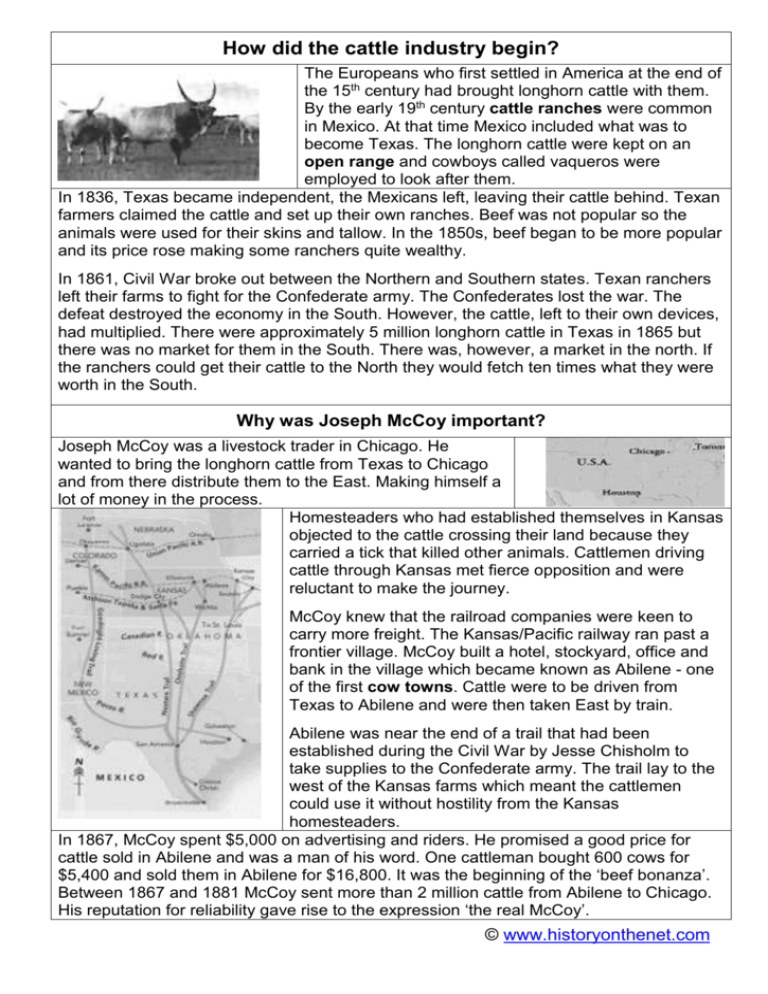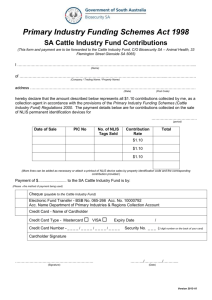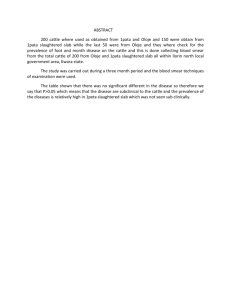How did the cattle industry begin
advertisement

How did the cattle industry begin? The Europeans who first settled in America at the end of the 15th century had brought longhorn cattle with them. By the early 19th century cattle ranches were common in Mexico. At that time Mexico included what was to become Texas. The longhorn cattle were kept on an open range and cowboys called vaqueros were employed to look after them. In 1836, Texas became independent, the Mexicans left, leaving their cattle behind. Texan farmers claimed the cattle and set up their own ranches. Beef was not popular so the animals were used for their skins and tallow. In the 1850s, beef began to be more popular and its price rose making some ranchers quite wealthy. In 1861, Civil War broke out between the Northern and Southern states. Texan ranchers left their farms to fight for the Confederate army. The Confederates lost the war. The defeat destroyed the economy in the South. However, the cattle, left to their own devices, had multiplied. There were approximately 5 million longhorn cattle in Texas in 1865 but there was no market for them in the South. There was, however, a market in the north. If the ranchers could get their cattle to the North they would fetch ten times what they were worth in the South. Why was Joseph McCoy important? Joseph McCoy was a livestock trader in Chicago. He wanted to bring the longhorn cattle from Texas to Chicago and from there distribute them to the East. Making himself a lot of money in the process. Homesteaders who had established themselves in Kansas objected to the cattle crossing their land because they carried a tick that killed other animals. Cattlemen driving cattle through Kansas met fierce opposition and were reluctant to make the journey. McCoy knew that the railroad companies were keen to carry more freight. The Kansas/Pacific railway ran past a frontier village. McCoy built a hotel, stockyard, office and bank in the village which became known as Abilene - one of the first cow towns. Cattle were to be driven from Texas to Abilene and were then taken East by train. Abilene was near the end of a trail that had been established during the Civil War by Jesse Chisholm to take supplies to the Confederate army. The trail lay to the west of the Kansas farms which meant the cattlemen could use it without hostility from the Kansas homesteaders. In 1867, McCoy spent $5,000 on advertising and riders. He promised a good price for cattle sold in Abilene and was a man of his word. One cattleman bought 600 cows for $5,400 and sold them in Abilene for $16,800. It was the beginning of the ‘beef bonanza’. Between 1867 and 1881 McCoy sent more than 2 million cattle from Abilene to Chicago. His reputation for reliability gave rise to the expression ‘the real McCoy’. © www.historyonthenet.com Activities Level 1, 2 Joseph McCoy has commissioned you to design an advertising poster to: 1. Encourage riders to work for him 2. Encourage Texas ranchers to send their cattle to Abilene. Level 3,4 A number of factors are important in the development of the cattle industry – eg the railroad, civil war etc. Design a poster showing how factors helped the cattle industry to develop. Activities Level 1, 2 Joseph McCoy has commissioned you to design an advertising poster to: 3. Encourage riders to work for him 4. Encourage Texas ranchers to send their cattle to Abilene. Level 3,4 A number of factors are important in the development of the cattle industry – eg the railroad, civil war etc. Design a poster showing how factors helped the cattle industry to develop. Activities Level 1, 2 Joseph McCoy has commissioned you to design an advertising poster to: 5. Encourage riders to work for him 6. Encourage Texas ranchers to send their cattle to Abilene. Level 3,4 A number of factors are important in the development of the cattle industry – eg the railroad, civil war etc. Design a poster showing how factors helped the cattle industry to develop.







